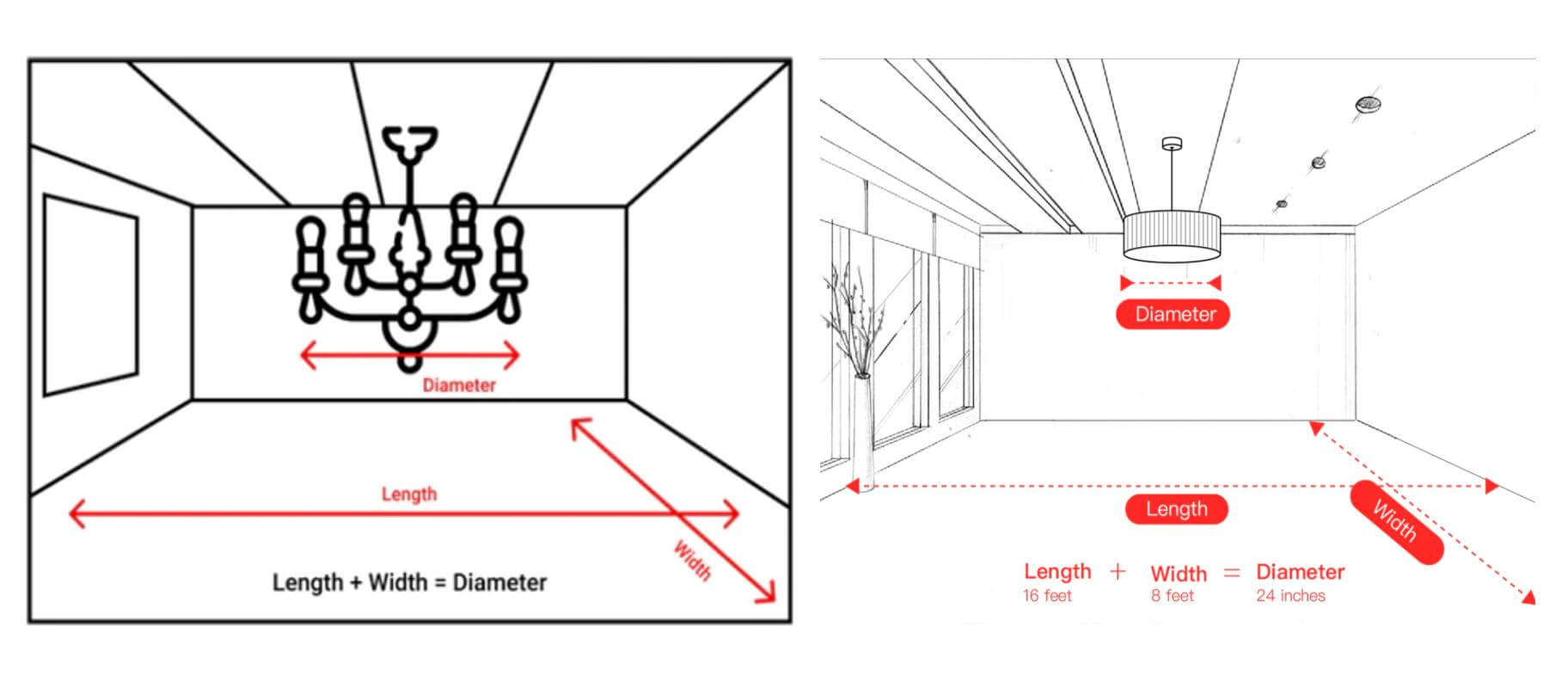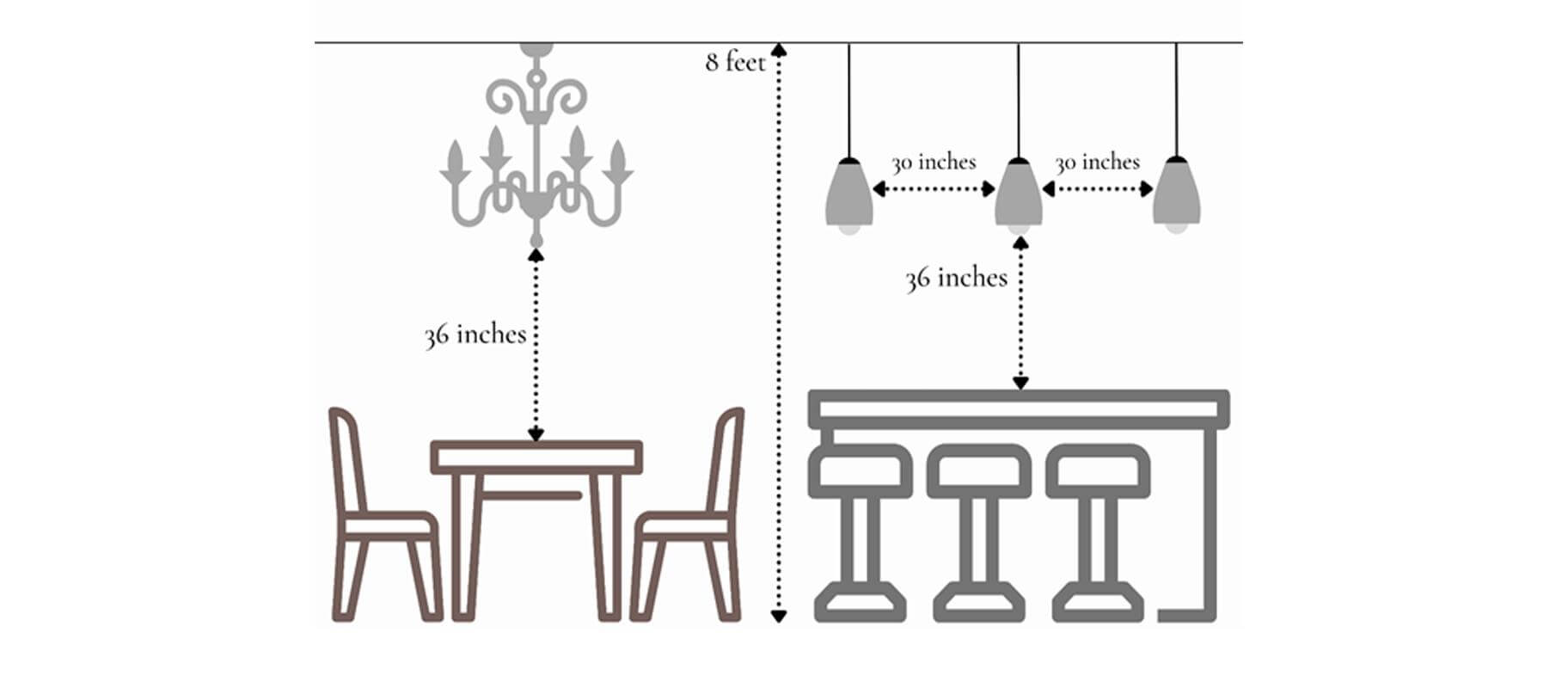Choosing the right size chandelier is not an easy task because there are so many variables that sometimes we don’t even know where to start. If the space is large, the small chandelier is easy to get lost, unable to deliver strong design elements, and the large chandelier will appear too overwhelming in a small space. The right chandelier is proportional to the height and width of the room and the size of the furniture in the room.
If you’re looking for a new chandelier that fits the size of your room, read on for our exclusive decor and sizing tips.
1. How to determine the size of the chandelier?
The following will tell you how to determine the size of the room chandelier and dining room chandelier.
1) How to determine the size of the room chandelier?
It is important to know how to properly adjust the size of the chandelier so as not to overwhelm the space. The standard formula for the size of the chandelier is to determine the diameter of the lamp according to the overall size of the room.
This rough estimate is a good starting point. Depending on the height of the room and the overall feel of the room size, you can add or subtract. For example, in a 2-story room, you can be larger than the diameter formula, but also see the room height equation below. The chandelier width for a square room is determined by the following formula: Add room length + room width, then convert to inches.
Example: 12 feet long room + 16 feet wide room = 28 inches
If you are looking for a 20 ‘x 20’ living room chandelier size, then a 40 “wide light fixture will be a good balance. If the room is larger and more rectangular, consider using two chandeliers.
2) How to determine the size of the dining room chandelier?
The following are Three steps to determine the size of the dining room chandelier.
#1. Determine the width of the chandelier
Divided into three steps:
- l Measure the length and width of the room
- l Add two measurements
- l Converts the unit of measurement from feet to inches
The converted sum is the ideal width (or diameter) of the chandelier. For example, if your dining room is 10′ x 18′, a chandelier with a diameter or width of 28″ will work best for your space. This applies regardless of the shape of the chandelier. However, for round or rectangular lamps, the length should be at least one-half of the length, but not more than two-thirds.
#2. Determine the height of the chandelier
Measure the ceiling height from the installation site to the floor. At this stage, make sure the installation site is at least 4 feet away from any adjacent walls.
For each foot, the chandelier height is estimated to be 2.5 inches to 3 inches
- l Multiply the ceiling height by the chandelier height
- l Converts measurement units to inches
For example, if your dining room ceiling is 8 feet high, then a 24-inch chandelier is best for your space.
Please note: The above calculation assumes that your ceiling height is proportional to the size of the room. Therefore, if you have a large room with a low ceiling or a high ceiling with a small room (such as a foyer), this may not apply.
#3. Determine the chain length
If your ceiling height is less than eight feet, the dining room chandelier should hang 30 inches to 34 inches from the tabletop to the bottom of the chandelier and be centered above the table. If your ceiling is higher than eight feet, the recommended clearance is 36 to 40 inches.
(Another related post: How to Install a Chandelier?)
2. What needs to be considered when choosing a size chandelier?
There are two factors below:
1) Width
Measure the length and width of the room in feet, then add the two numbers together. Then use that number as the width (in inches) of the chandelier. For example, if your room measures 10′ x 16′, their sum equals 26′. The chandelier should be 26 inches wide.
However, if you place the chandelier on a table, it should be 12 inches narrower than the width of the table so that you don’t hit the chandelier when entering and exiting the seat.
2) Height
For the height of the chandelier, we recommend 3 inches per foot of space between the floor and ceiling. You can find the number by multiplying the ceiling height in feet by 3. For example, if your ceiling is 8 feet high, your chandelier is 3 inches tall. The chandelier height should be 24 inches (8 x 3 = 24).
3. How to choose the diameter of the chandelier?
When choosing a chandelier for most Spaces, a general rule of thumb will give you a good guide to choosing the size:
Width (in feet) + room length (in feet) = diameter/width of chandelier (in inches).
So, for example, if your room is 14 feet long and 10 feet wide, a 24-inch diameter chandelier would look just right (14 feet + 10 feet = 24 feet, which you can convert to inches).
If your lighting is focused on the seating area rather than the entire room, use the approximate length and width measurements for that area rather than the entire space. Another way to calculate this value is to add the length of the light emitted from the two nearest walls and then double it to get an approximate chandelier diameter in inches.
For example, if the center of the seating area is 7 feet from one wall and 8 feet from another wall, then 7 feet + 8 feet = 15 feet; 15 feet x 2 = 30 feet, which you can convert to inches. Therefore, a 30-inch diameter fixture is more suitable.
(Another related post: Crystal Chandelier VS. Glass Chandelier: What is the Difference?)
4. How to choose the vertical size of the chandelier?
Now that you know the width and diameter of the luminaire, you need to choose the vertical size of the luminaire (not the height off the ground, but the actual top to height) of the bottom side of the unit itself).
To choose the vertical size of a chandelier, the classic rule is to calculate the height of the room (in feet) and multiply it by 2.5 to 3 to get a good range (in inches) of the vertical proportions of the lights.
So if your room has an 8-foot ceiling, that means your chandelier is about 24 to 32 inches from top to bottom. (8 feet x 3 = 24 feet; 8 feet x 4 = 32 feet. Convert to inches to get 24 to 32 inches.)
For 10-foot ceilings, 30 to 35 inches would be a more appropriate ratio. (10 feet x 3 = 30 feet; 10 feet x 3.5 = 35 feet. Convert to inches to get a range of 30 to 35 inches).

(Another related post: Chandelier Buying Guide)
5. How to choose the size when you want to hang multiple chandeliers?
To hang multiple chandeliers on a table, divide the table width by the number of chandeliers plus one, and use the result as the width or diameter of each chandelier. When installing the chandelier, its spacing is the same as the width of the chandelier.
For example, if you want to hang two chandeliers over a table that is 72 inches long (72 divided by 2+1), each chandelier will be 24 inches wide, and they should hang 24 inches from the ends of the table. The table.

(Another related post: Chandelier VS. Pendant Light: What is the Difference?)
6. How to choose the appropriate chandelier size for different scenes
There is a useful formula to help you adjust the size of the chandelier for the room, so grab a tape measure, pen, and some paper and jot it down for your planning.
1) For a room
Room width (ft) + room length (ft) = chandelier diameter (in)
For example: for a 10′ x 10′ room, you will need a chandelier no larger than 20 inches in diameter
2) For the corridor
Corridor width (feet) x 2 = Minimum diameter of chandelier (inches)
Corridor width (feet) x 2.5 = Maximum chandelier diameter (inches)
For example, for a 4-foot wide hallway, keep the chandelier in the 8 – to 10-inch diameter range.
3) Restaurant
The chandelier above the dining table has some special considerations. First, it should be low enough to create an intimate atmosphere, but not get in anyone’s way. Hanging the bottom of it 30 to 34 inches above the table is a good rule. And make sure it’s no wider than the table – at least not any part low enough for someone to bump their head.
In terms of length, the chandelier is best to be half to two-thirds the length of the table to create a good balance of proportions.
4) Others
When you’re trying to determine the dimensions of the chandelier, remember that you don’t want people to walk into it. When measuring the room, know the approximate range of suitable chandelier heights in the available space. To determine the height of a chandelier, there is another useful formula that can help you determine a range that will help match the proportions.
For chandelier height:
Room height (ft) x 2.5 = Minimum chandelier height (in inches)
Room height (ft) x 3 = Maximum chandelier height (in inches)
For example, a room that is 8 feet tall can have chandeliers that are 20 inches to 24 inches tall.
It is worth noting that the height of the chandelier includes the boom or chain as well as the light fixture itself. It is best to plan the bottom edge of the chandelier to be no more than six and a half to seven feet above the ground.
(Another related post: A Quick Guide to Chandelier Crystal Quality)
7. Chandelier size FAQ
Here are three common questions:
1) How high should I hang the chandelier above the dining table?
The American Lighting Association (ALA) recommends hanging the bottom of the light fixture no more than 30 inches from the top of the table. In fact, if you have a standard 30-inch high table, the fixtures will hang 5 feet above the ground and be hard to see below.
We recommend using 36 inches to be able to see below the light fixture and to leave more room for the beautiful flower arrangement in the center of the table in most applications. For every foot over 8 feet, you can add 3 inches of height to the 30-inch standard. For example, a 12-foot ceiling should hang the light fixture 42 inches above the table.
2) What size chandelier should I hang on my nightstand?
Hanging light fixtures on your nightstand will not only clear valuable space on your nightstand but also create an eye-catching and comfortable way to light your bedroom. Often, chandeliers are too large to hang from a nightstand, and you may want to consider decorative chandeliers.
However, the general rule is the same as most tables, look at the dimensions of the chandelier being the diameter of the nightstand ⅓ to ½. The hanging height of the chandelier or chandelier on the nightstand is usually 24 inches above the nightstand.
3) What size chandelier should be used when installing two chandeliers on the kitchen island or long table?
Modern homes often have many pendant lights or chandeliers installed on the kitchen island, and sometimes on the very long dining table. A good starting point is to use the rule of thirds. In this case, however, we want to balance the fixtures with negative space.
We developed two formulas for the width of the chandelier in this case. Formula 1: Divide the length by 5 and calculate the three negative space values as well as the dimensions of the chandelier.
For example: a 10-foot long kitchen island or dining table divided by 5, provides equal negative space at 2 feet and a 24-inch wide chandelier. This is a good rule of thumb to start with. Formula 2: Divide the total length by 2, then divide by 2. For a 10-foot-long table, you would have 5 feet (60 inches), then divide that by 2 to equal 30 inches of fixtures.
The distance between fixtures shall be equal to the diameter of each piece. Conclusion: Choose a 24 – or 30-inch light fixture for a 10-foot wide table, and make sure the chandeliers are 24 – or 30-inch apart after installation.
(Another related post: Hotel Lobby Chandeliers: A Full Guide)
8. Conclusion
The above is all about how to choose the right size chandelier and all introduction. If you have any questions or are interested in our products, please feel free to contact us.






Leave A Comment